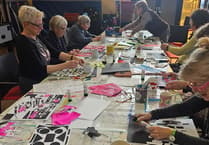A resource in the South Hams of thousands of books, articles, land deeds and records is open to everyone.
The Devon Rural Archive, situated in the grounds of the Shilstone Estate in Modbury, is open to the public to use for their own research purposes, and all for free.
The Devon Rural Archive began as a research project into the manor houses and farmhouses of the area, based initially on the 1765 map by Benjamin Donn.
The map, which in itself is fascinating, features well-known local places, but some less-well-known spellings - Salcomb, Marlborough, Bur Isle, Aveton Giffard - and some landowners’ names, ones that had sponsored the creation of the map under the proviso that they be named on the finished product.
Nearly 1,000 sites have been identified for further investigation by the DRA team, and so far they have reported on approximately 160.
They realised the material they came across during their research could be valuable to other people, so the Devon Rural Archive was built around that, with their stunning building with double-height archive room opened in 2009.
Not only is the upstairs archive open to the public, but they also regularly hold lectures on lots of different subjects in one of their purpose-built lecture rooms downstairs.
The open shelves hold general and local information, planning projects, sales particulars, census returns, parish records, manuscripts etc, each divided into specific parishes.
Abi Gray, the lead archaeologist, now has a team of 14 volunteers who work to catalogue the information sent to them, to work to upload information to the image banks or transcribe and translate older documents.
The Devon Rural Archive sits in the grounds of Shilstone House, which has had settlements on the site since 1066 and was bought by Lucy and Sebastian Fenwick in 1997. The came across the house in a state of disrepair, with one side of it having fallen down due to a previous owner trying to build it on the cheap.
They decided to buy it and renovate it back to its original beauty. While most people in this situation would chose one period to renovate a building to, the Fenwicks have decided to chose three. They have based different areas of the building on the Georgian period, circa 1730, the Stuart period, 1690, and Tudor, 1600.
While this might give the impression that the building ends up as a mismash of design and eras, but the effect is incredibly subtle and you move from one era to the next smoothly, more often than not actually needs pointing out before you notice.
In fact the renovation project, which is still ongoing, following designs by architect Christopher Rae-Scott, has won Country Life Magazines’ ‘Restoration of the Century’ award and The Georgian Group’s ‘New Building in the Classical Tradition’ award.
All of the carpentry work is done by the team on site, and right now they are working to produce the ornate wooden wall panels for one of the Tudor rooms.
There are lovely little things to discover when you walk around the Shilstone grounds. You can see the original ha ha walls, which are recessed walls created with a ditch on the far side. This means that as you look across your land from your grand house, the landscape and your view is uninterrupted, but livestock and peasants are still kept out.
There is also an old water theatre, thought to be the only one in the UK, a road that has been dropped into the landscape, apparently so the peasants couldn’t be seen moving backwards and forwards from the house, and reflection lakes; tiered in the grounds and designed to reflect the house in the surface of the water.
It really is a stunning place, and Abi is a font of knowledge of everything Shilstone. Many thanks to her for giving me a tour and allowing me to annoy her for a good few hours.
You can find out more about the DRA on the website: www.devonruralarchive.com or contact them on 01548 830832 or by email: [email protected]




